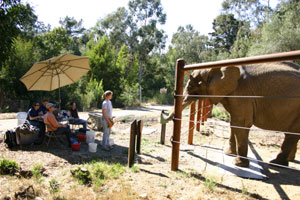 How does an elephant know to avoid a hungry lion pride to the west from miles and miles away? They have friends who call them with the 411, dialing direct to their feet.
How does an elephant know to avoid a hungry lion pride to the west from miles and miles away? They have friends who call them with the 411, dialing direct to their feet.
According to expert Caitlin O'Connell-Rodwell, Elephants use their voices to create sounds, which transfer into waves through the ground. The elephants receive the information through vibration sensitive cells in their feet, particularly in the toes, heels and even the trunk. According to one acoustic specialist, an elephant foot resembles a satellite disc (or perhaps the other way around). The waves, or vibrations, travel up the leg bone of another elephant, through the shoulder and to the middle ear bones, where they are processed in the auditory cortex region of the brain.
When trying to receive a vibration, elephants put their weight on their two front feet, flatten their ears at their side and lay their trunks on the ground.
Elephants also seem to recognize who the message comes from. If it is from a reliable source, like a trustworthy friend, they listen and respond. A warning call elicits protective behavior, such as moving together or leaving the area. If it is just random rumblings, the call is ignored.
Ms. O'Connell-Rodwell and Oakland Zoo animal curator Colleen Kinzley have been studying elephant vibrations in Namibia. The study will appear in the Journal of the Acoustical Society of America in August. Seismic testing also takes place at the zoo with our own resident sound expert, our elephant Donna.
